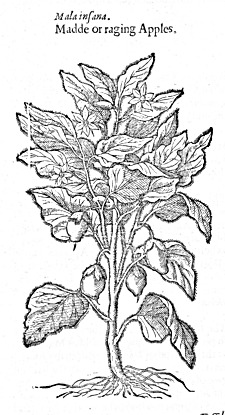
Gerard's Herbal - Part 2

Fig. 548. Mad Apple
The Description.
Mad Apple hath a round stalk of two foot high, divided into sundry branches, set with broad leaves somewhat indented about the edges, not unlike the leaves of white Henbane, of a dark brown-green colour, somewhat rough. Among the which come the flowers of a white colour, and sometimes changing into purple, made of six parts, wide open like a star with certain yellow chives or thrums in the middle; which being past the fruit cometh in place, set in a cornered cup or husk after the manner of the great Nightshade, great and somewhat long, of the bigness of a swan's egg, and sometimes much greater, of a white colour, sometimes yellow, and often brown, wherein is contained small flat seed of a yellow colour. The root is thick, with many threads fastened thereto.
The Place.
This plant groweth in Egypt almost everywhere in sandy fields even of itself, bringing forth fruit of the bigness of a great Cucumber, as Petrus Bellonius reporteth in the second book of his Singular Observations.
We had the same in our London gardens, where it hath borne flowers; but the winter approaching before the time of ripening, it perished: notwithstanding it came to bear fruit of the bigness of a goose egg one extraordinary temperate year, as I did see in the garden of a worshipful merchant Mr Harvie in Lime Street, but never to the full ripeness.
The Time
This herb must be sown in April in a bed of hot horse dung, as Musk-Melons are, and flowereth in August.
The Names.
Petrus Bellonius hath judged s it to be Malinathalla theophrasti. In the Dukedom of Milan it is called Melongena and of some, Melanzana: in Latin, Mala insana: and in English, Mad Apples: in the German tongue, Dollopffell: in Spanish, Verangenes.
The Nature.
The herb is cold almost in the fourth degree.
The use and danger.
A. The people of Toledo do eat them with great devotion being boiled with fat flesh, putting thereto some scraped cheese, which they do keep in vinegar, honey, or salt pickle all winter to procure lust.
B. Petrus Bellonius, and Hermolaus Barbarus, report that in Egypt and Barbary they use to eat the fruit of Mala insana boiled or rosted under ashes, with oil, vinegar, & pepper, as people use to eat mushroms. But I rather wish English men to content themselves with the meat and sauce of our own country, than with fruit and sauce eaten with such peril; for doubtless these apples have a mischievous quality, the use whereof is utterly to be forsaken. And as we see and know many have eaten and do eat Mushroms more for wantonness than for need: for there are two kinds thereof venomous and deadly, which being in the handling of an unskilful cook, may procure untimely death. Therefore it is better to esteem this plant and have him in the garden for your pleasure and the rareness thereof than for any virtue or good qualities yet known.